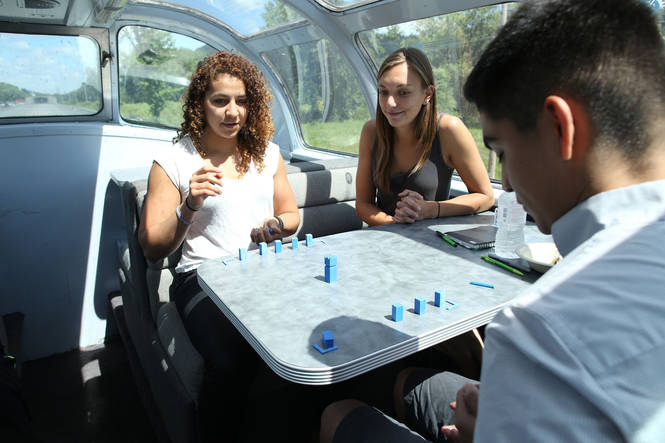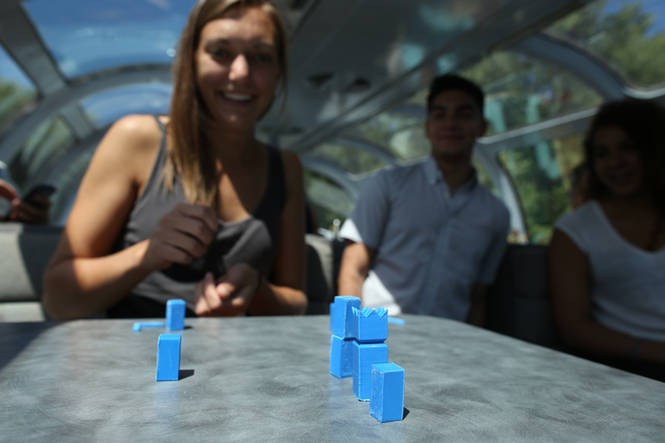Future Now
The IFTF Blog
3D Printing a Lawn Game on a Train
This article originally appeared as "The Kubb Train" in Kubbnation Magazine. This annual magazine is the only publication for Kubb, a Swedish lawn game. Photos by Tyler Metcalfe.

For 10 days this summer I was one of 25 participants in The Millennial Trains Project, a 10-day transcontinental journey for young innovators to explore our generation’s most urgent challenges. Each participant had a personal, professional, or creative project that he or she worked on in each of the seven cities along the way. Between cities, we were joined by distinguished mentors to dig deep into conversations about leadership, civic participation, social innovation, and aspirations for the future of our generation. The train became a mobile innovation lab and everyone on board took inspiration from the diverse landscapes through which we passed. Among those 25 participants were several aspiring Kubb players. This is a story about how playful creativity, a mindset that you should always make your good ideas real, and access to new manufacturing tools facilitated a very fateful Kubb experience on board the train.
Inside our caravan of vintage railcars, we had access to the latest 3D printing and digital craftsmanship tools in the Millennial Maker Space. EKOcycle, a CocaCola initiative to reduce waste from plastic coke bottles by recycling them into new objects, paired up with 3D Systems to make the Cubify 3D printer, which uses recycled plastic as filament. They converted our lounge into “an interactive environment designed for Millennials to discover how 3D printing can create new businesses, transform entire industries and push the frontiers of American manufacturing, as well as the possible applications of the technology to their own projects.”

Toward the beginning of our journey, a fellow passenger, Tyler Metcalfe, and I discovered our mutual love for Kubb. We had to pack pretty light for 10 days in the close-quarters of a train, so neither of us brought our Kubb set on board. So, we decided to 3D print a miniature, table-top Kubb set. Neither of us had experience with 3D modeling software, so we were thrilled to find that we were not the first to have this idea. Another Kubb-lover had already uploaded an open-source 3D model to Thingiverse, an online library of 3D models. Late one night we downloaded the file, loaded it to the Cubify printer, hit “print,” and waited with anticipation for the next morning. We awoke to our very own 1/6th size Kubb set.
Playing on a moving train proved to be about as challenging as you would imagine. But as we rolled out of St. Paul toward Milwaukee, we enjoyed many raucous rounds of mini-Kubb. We crossed the Mississippi and watched hundreds of miles of great midwestern fields fly by and all the while people faced off on the mini-Kubb field. Hoping to enlighten our fellow passengers, we did a bit of research on the history of the game, which is when we discovered that Eau Claire is the Kubb capital of North America. It couldn’t be a coincidence that our train was passing just miles south of Eau Claire at that exact moment. Some might say it was the rumbling of the train, but I am fairly certain that I saw the King wobbling toward the North, giving in to the gravitational Kubb-pull of Eau Claire. It was with great delight that we learned about Kubbnation Magazine and were instantly dedicated to sharing our story with the larger community of Kubb players.
Taken in isolation, it would be easy to ignore the significance of the events that transpired: using a 3D printer to make a plastic version of a game, connecting to an online community of people with shared interests, having Wikipedia at the tip of our fingers to instantly learn a few pieces of trivia. But in aggregate, this is a remarkable example of our new reality. We were able to have an idea, manifest a physical artifact of it, catalyze a social experience, and engage in a micro-learning moment that left us all feeling awestruck. The experience embodies the spirit of the Millennial Trains Project – if you have an idea just do it, and then figure out how you can make it extraordinary. There is no reason not to go all out, and if your idea is good, it will only flourish and grow once you put it out to the world and let other people build on it.
Tyler and I divided our mini Kubb set in half. He stayed on the East Coast and I flew back to the West Coast. Someday we will meet again in the Midwest and have an epic mini-Kubb reunion battle.

The experience described here is illustrative of several of IFTF's forecasts about the future of learning, making, and manufacturing. For more on these topics, please see these public research reports and maps:
- Future of Learning: From Educational Institutions to Learning Flows
- Open Cities: How the maker mindset is reinventing urban life
- Future of Making



